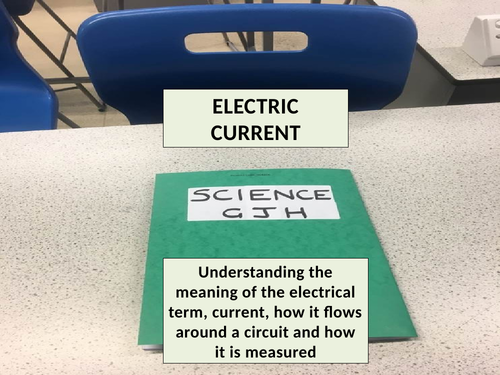

An engaging lesson presentation (30 slides) that looks at electric current and ensures that students know the key details about this factor in preparation for their GCSE studies. The lesson begins by forming a definition for this electrical term and then as the lesson progresses, this definition is broken so that each element is understood. Students will be introduced to the difference between electron flow and conventional current. Time is taken to ensure that students understand that an ammeter must be set up in series. The remainder of the lesson will focus on the mathematical calculations which include current and important skills such as converting between units is covered.]
As stated above, this lesson has been designed primarily for those students taking their GCSE exams (14 - 16 year olds in the UK) but is suitable for younger students too.
Get this resource as part of a bundle and save up to 44%
A bundle is a package of resources grouped together to teach a particular topic, or a series of lessons, in one place.
Electrical circuits
This bundle of 11 lessons covers the key details about electrical circuits that students need to know for their GCSE studies. It could also be used with younger students at KS3 who are studying this topic. All aspects of the topic are covered such as series and parallel circuits, electrical current, resistance and potential difference and the components found in these circuits. In addition, there are lessons on plugs, mains electricity and the National Grid so that students can make links between these topics. All of the lessons are detailed and engaging and students will contain regular progress checks so that students can assess their understanding
Topic P3.2: Simple circuits (OCR Gateway A GCSE Combined Science)
This bundle of 9 lessons covers all of the content in the sub-topic P3.2 (Simple circuits) of the OCR Gateway A GCSE Combined Science specification. The topics covered within these lessons include: The differences between series and parallel circuits Represent direct current circuits with the common electrical symbols Current and the dependence on resistance and potential difference Recall and apply the relationship between I, V and R The graphs for thermistors and LDRs Diodes Net resistance Current, potential difference and resistance calculations in series and parallel circuits Power transfer in a circuit Applying the equations to do with electrical circuits All of these lesson presentations and accompanying resources are detailed and engaging and contain regular progress checks to allow the students to constantly assess their understanding.
Topic P2: Electricity (AQA Trilogy GCSE Combined Science)
This bundle of 11 lessons covers the majority of the content in Topic P2 (Electricity) of the AQA Trilogy GCSE Combined Science specification. The topics covered within these lessons include: Circuit diagram symbols Electric charge and current Current, resistance and potential difference Resistors Diodes Series and parallel circuits Electricity in the home Power The National Grid All of these lesson presentations and accompanying resources are detailed and engaging and contain regular progress checks to allow the students to constantly assess their understanding.
Topic P3: Electricity and Magnetism (OCR Gateway A GCSE Combined Science)
This bundle of 9 lessons covers a lot of the key content in Topic P3 (Electricity and magnetism) of the OCR Gateway A GCSE Combined Science specification. The topics covered within these lessons include: Current and charge Potential difference Electrical circuit symbols Resistance and Resistors Circuit devices Series and parallel circuits Circuit calculations Energy and power in circuits All of these lesson presentations and accompanying resources are detailed and engaging and contain regular progress checks to allow the students to constantly assess their understanding.
Something went wrong, please try again later.
This resource hasn't been reviewed yet
To ensure quality for our reviews, only customers who have purchased this resource can review it
Report this resourceto let us know if it violates our terms and conditions.
Our customer service team will review your report and will be in touch.